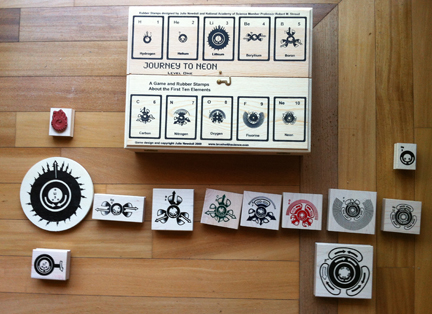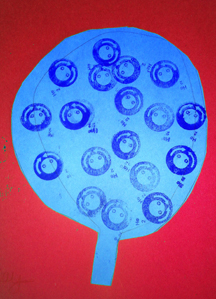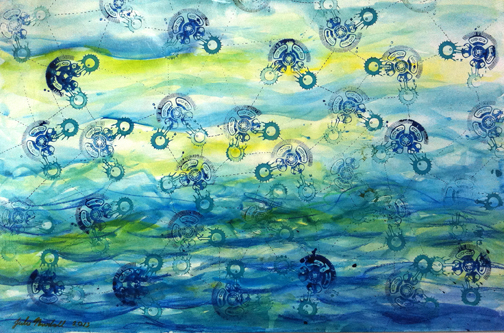How use the
Rubber Stamps of the First Ten Elements
Introduction to Neutrons and Isotopes
All stamps are correctly sized relative to each other based on the atomic radius of each element. Two elements, fluorine and lithium, also come as ions for size comparison when an atom gains or loses an electron.
Video showing how to use the rubber stamps and how they are designed.

The secret symbols designed into the stamps - what does it all mean?
Watch the next video to see what the symbols in the stamps mean. Some fun facts about orbitals are explained. Remember, the stamps are designed to made single bonds. See why and see if you made your compounds correctly.
Potion Traders
Once you have made a stack of molecules with the stamps, you can battle them in a game of Potion Traders. You can have one noble gas stamped on your paper, a lithium-fluorine ionic attraction pair, or any compound you can think of involving only single bonds and the stamps. These you can battle by picking six parameters and assigning these parameters to the number 1-6. All players put one of their potions on the table and one player rolsl the die. Lets say your parameters were:
1 - lightest (add all the proton numbers of the atoms in your compound together and compare).
2 - noble gas
3 -
most atoms in a compound
4 - ionic attraction (lithium fluoride wins if there is one).
5 - greenhouse gas (look these up)
6 - most poisonous (fluoride gas is a likely candidate).
You can also call "opposites" before you roll, and the opposite would win (such as the heaviest for a roll of "1"). The winning compound is placed, with the player's name on it, in the potion pile. Losing molecules go in the player's discard stack. When all molecules have been battled, the one with the most ingredients in the potion pile gets to name the magic potion.
If you know how to draw chemical formulas, or you want to learn how, jot down the potion ingredients (winning molecules) using Lewis structures or Formularrows, found in the last section of the Teacher's Guide. Then give the potion your title and put it in your book of spells and potions.
Make an art piece featuring a helium, hydrogen and water balloons
For a fun chemistry art project, draw a large balloon on a piece of construction paper. On this, stamp helium impressions with the rubber stamps to make a helium balloon, or water impressions to make a water balloon using the oxygen and hydrogen stamps. Two hydrogens bonded together to form hydrogen gas would make a very explosive balloon! Once the balloon has been stamped, it can be cut out and pasted onto a second piece of paper, creating a nice piece of artwork.
Thinking about surface tension while painting with watercolors
Hydrogen bonds are the focus of this art project using the rubber stamps. If you are using a water based ink for the stamps, you should first make a watercolor painting of your impression of water on a nice piece of watercolor paper. Then, use the oxygen and hydrogen stamps to make water on top of your painting. Draw dotted or dashed lines between the oxygen on one water molecule to the hydrogen of the nearest water molecule, and you might end up with something like this image on the left. Water using the stamps is on the right. Notice that the electron arrows of the hydrogen fit into an arrow shaped slot on the oxygen:


More details about art projects and the science behind the stamps may be found in the Teacher's Guide section.